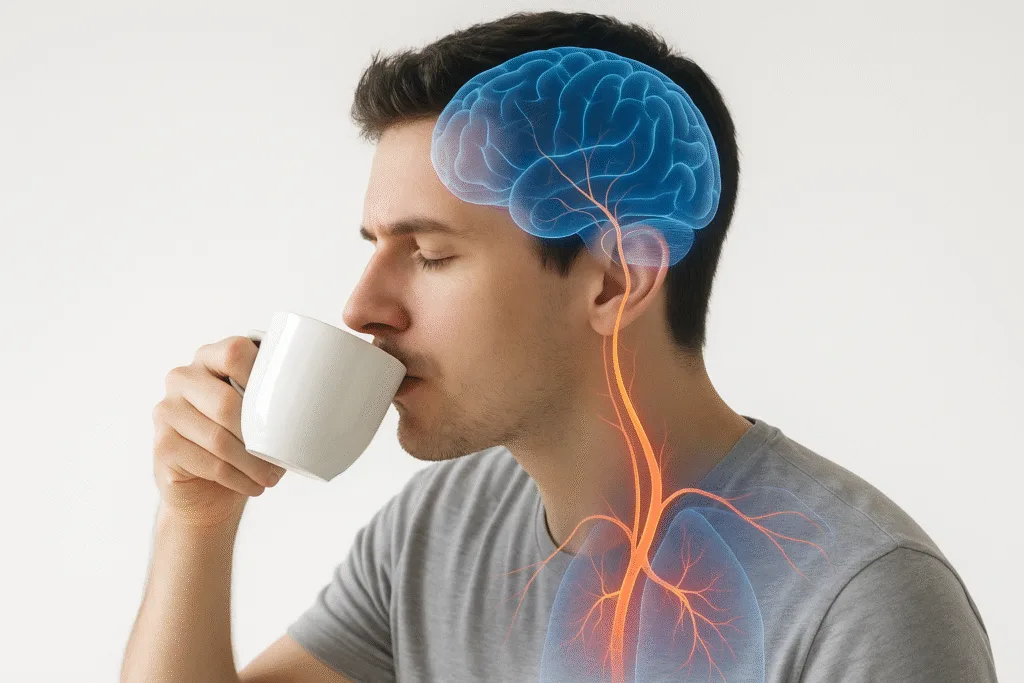The caffeine reaction test shows how quickly your brain responds to the first sip of coffee, tea or any caffeinated drink. Most people believe caffeine takes 20 to 30 minutes to “kick in,” but your nervous system reacts to caffeine far sooner — sometimes within seconds. This experiment demonstrates the immediate neurological and physiological changes triggered by the very first sip.
Caffeine influences alertness, focus, blood flow and your brain’s reward pathways. When you perform the caffeine reaction test, you can observe these effects in real time, long before the caffeine is fully absorbed.
Let’s begin.
Step 1 — Sit Calmly With No Caffeine for at Least 2 Hours
Before starting, ensure you haven’t consumed caffeine recently.
Sit still, relax your shoulders and breathe normally.
Why this matters
To observe the initial reaction, your system must be free from recent stimulation. This creates the baseline needed for the caffeine reaction test.
Step 2 — Close Your Eyes for 5 Seconds and Focus on Your Mental State
Pay attention to:
- mental clarity
- alertness level
- physical energy
- motivation
- overall mood
Why this helps
Your brain’s pre-sip state acts as the reference point for comparing the immediate effects of caffeine.
Step 3 — Take a Slow, Single Sip of a Caffeinated Drink
Use:
- coffee
- iced coffee
- black tea
- energy drink
- espresso
- cold brew
Take just one sip.
What happens instantly
Your tongue’s bitter receptors activate neural pathways faster than absorption occurs. This is the start of the caffeine reaction test.
Step 4 — Notice the Immediate Neurological Reaction
Within the first 3 to 10 seconds, focus on:
- slight increase in alertness
- sharpened focus
- subtle mood lift
- increased awareness of surroundings
Why
Your brain interprets bitterness as “incoming stimulation,” activating anticipation circuits related to dopamine and alertness.

Step 5 — Pay Attention to Breathing and Posture Changes
After the sip:
- your posture may straighten
- your breathing rhythm shifts slightly
- your eyes focus more sharply
Why this matters
Caffeine stimulates the autonomic nervous system, triggering micro-adjustments even before absorption begins.
Step 6 — Observe Your Heart Rate for 15 Seconds
Place two fingers on your wrist or neck.
Count the beats.
What you’ll notice
A subtle increase may appear almost immediately due to:
- taste-triggered anticipation
- early neural stimulation
- expectation-based physiological response
This reinforces the caffeine reaction test.
Step 7 — Take Another Sip After 1 Minute
Wait exactly one minute.
Now take a second sip.
What happens
This creates a noticeable jump in:
- alertness
- focus stability
- mental readiness
The brain now begins activating adenosine receptor antagonism — caffeine’s primary mechanism.
Step 8 — Compare Your Focus Before and After the First Sip
Look at:
- a small text
- a phone icon
- a distant object
- your hand
Focus on it for 3 seconds.
What you’ll notice
Your ability to hold attention improves in small but measurable ways — a core feature of the caffeine reaction test.
Step 9 — Observe Mood and Motivation for 10 Seconds
Pay attention to:
- increased readiness
- reduced mental fog
- slight uplift in mood
- increased willingness to act
Why
Caffeine stimulates the dopaminergic reward system connected to motivation and drive.
Even the anticipation of caffeine boosts these effects.
Step 10 — What This Everyday Habit Reveals About You
The caffeine reaction test uncovers important insights:
1. Your brain reacts before caffeine is absorbed
Taste receptors and neural anticipation create instant stimulation.
2. Caffeine affects mood and alertness very quickly
Within seconds, cognitive activity intensifies.
3. You don’t need a full cup for an effect
The first sip activates neurological pathways.
4. Your autonomic nervous system responds instantly
Posture, breathing and heart rate adjust automatically.
5. Dopamine plays a major role
Caffeine’s motivational effect begins earlier than absorption.
6. Caffeine’s power is partly psychological
Expectation amplifies the physiological response.
7. Your daily habits trigger predictable reactions
Your body recognizes patterns and reacts reflexively.
The caffeine reaction test demonstrates how the brain anticipates and accelerates responses to familiar stimulation.
Next Everyday Experiment You Should Try
If the caffeine reaction test revealed how fast your brain responds to stimulation, the next everyday experiment shows how your eyes react to smartphone scrolling and visual overload.
Recommended next article:
“The Scrolling Vision Strain Test — What Happens to Your Eyes After 2 Minutes of Scrolling”
